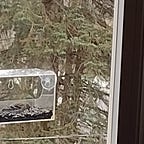Weather is coming for us, are we ready?
Seventy years ago, our little town in New England was laid waste by a tremendous flood. Fifty-three years before that, in 1927, the area experienced a similar devastating flood. In response to these two events the Army Corps of Engineers designed and built flood chutes in vulnerable communities around Massachusetts.
At the time, manufacturing was still a major job provider in New England, not the economic heart of the place, as it had been in the 1800’s but still a major part of New England culture and a foundational pillar of the economy. Mills were built next to rivers to take advantage of hydroelectric power. The same river that delivered the means to run the big machines suddenly threatened to destroy the mills altogether. So, communities took action and the flood chutes were built.
A river in a flood chute looks like a river in jail. 15 foot high concrete walls surround it, the riverbed is also concrete. Nature is not allowed inside such a river. It’s a pitiful sight. But as I watch the rain pelting down outside my office window and see the storm drains that drain into the flood chute on the river beside our loft, my feelings about that captive river are more ambivalent than they are on sunny days when a kingfisher or a blue heron stands on the wall of the flood chute assessing their chances at finding a fish in the sanitized flow of water on concrete below.
I feel sorry for the river. I want the birds to have their fishing spot back. I want the fish to hav their homes. I would prefer to see the trees standing tall on the riverbank rather than see them as they are, leaning with all their might over concrete walls that will never let them reach that flowing water.
On days like today, I look at footage of Leominster, a town without flood chutes, and I look at our river and I understand it is not a benign force that needs our help, it is also a potential killer in a box.
I think we’re doing our best to reduce our carbon footprint. We live in a retrofitted cotton mill. We do not use air conditioning even during the exceptional heat waves we’ve had over the last five summers. We compost. We recycle. We buy used whenever possible, (I don’t think we own more than three pieces of furniture bought new) we don’t use disposable things ever. We keep the lights out until it’s too dark to see inside the loft. We’re doing all the things we should be doing. I used to think we should also find a way to eliminate the flood chutes. Today, I’m not so sure.
The really sobering thing about all of this is that despite the torrential rains, the unpredictable winters and the increasingly hot summers we have in our area, we are becoming a climate haven.
“Firebirds” fleeing from the California wildfires, are buying up properties in our neck of the woods. More arrive every year. It’s the same whether you’re in Massachusetts, New Hampshire, Vermont or Maine. Connecticut seems to have been spared this phenomenon, probably because it’s known as a bedroom community for NYC and so many Californians feel an innate antipathy for NYC. Honestly, I don’t know what’s going on in Rhode Island, but does anyone ever know what’s going on in Rhode Island?
New Yorkers are fleeing to the Hudson Valley and areas further upstate. Local resources here are spread between all of these states, all of which are within easy reach of each other, so it’s difficult not to notice these migratory patterns as they change the landscape for everyone. Of course, all of the people moving here are in favor of naturalizing the environment as much as possible. They like composting, recycling and all of the carbon neutral things too. They buy Teslas and other EVs, they’re a reminder that we need to take action to reduce our carbon footprint and most of us welcome that. But they’ve never been through a New England flood. They weren’t even her when Irene swept through filling the chutes to within a foot of the top of the walls, well over their intended capacity. They don’t understand that we are responding to damage already done in the way we live here. We’re not preventing anything, we’re just trying to keep it all together.
The flood chutes are ugly. They’re old and soon they will start to break down. When they do, we will be confronted with an unpleasant reality; polite responses to climate change aren’t working. We are going to need to make bigger sacrifices if we want to see results. We are going to need to choose solutions that don’t give us comfort or make life more gracious sometimes. If we don’t want the flood chutes, we are going to have to accept that the buildings next to the river will, sooner or later, be destroyed and when they are destroyed, we are going to have to resign ourselves to leaving that area undisturbed, no “building back better,” no building back at all.
That means, sitting here at my desk, in my office with its exposed brick wall and its 10 foot tall windows, I need to understand we are living on borrowed land. Sooner or later, nature is going to take it back. Not sure how I feel about that. For today, the river inside the flood chutes doesn’t look quite so pitiable or ugly as usual. I do know that much.
